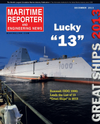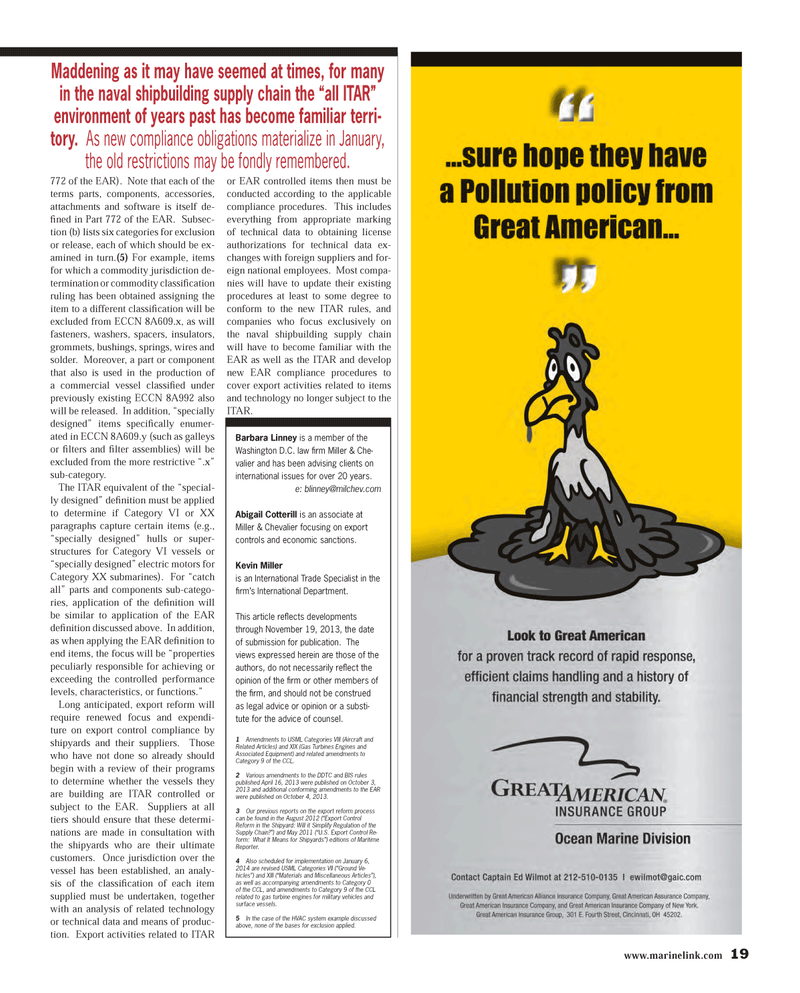
Page 19: of Maritime Reporter Magazine (December 2013)
Great Ships of 2013
Read this page in Pdf, Flash or Html5 edition of December 2013 Maritime Reporter Magazine
www.marinelink.com 19Barbara Linney is a member of the Washington D.C. law Þ rm Miller & Che- valier and has been advising clients on international issues for over 20 years. e: [email protected] Abigail Cotterill is an associate at Miller & Chevalier focusing on export controls and economic sanctions. Kevin Milleris an International Trade Specialist in the Þ rmÕs International Department. This article reß ects developments through November 19, 2013, the date of submission for publication. The views expressed herein are those of the authors, do not necessarily reß ect the opinion of the Þ rm or other members of the Þ rm, and should not be construed as legal advice or opinion or a substi-tute for the advice of counsel.1 Amendments to USML Categories VIII (Aircraft and Related Articles) and XIX (Gas Turbines Engines and Associated Equipment) and related amendments to Category 9 of the CCL. 2 Various amendments to the DDTC and BIS rules published April 16, 2013 were published on October 3, 2013 and additional conforming amendments to the EAR were published on October 4, 2013. 3 Our previous reports on the export reform process can be found in the August 2012 (?Export Control Reform in the Shipyard: Will it Simplify Regulation of the Supply Chain??) and May 2011 (?U.S. Export Control Re- form: What It Means for Shipyards?) editions of Maritime Reporter. 4 Also scheduled for implementation on January 6, 2014 are revised USML Categories VII (?Ground Ve- hicles?) and XIII (?Materials and Miscellaneous Articles?), as well as accompanying amendments to Category 0 of the CCL, and amendments to Category 9 of the CCL related to gas turbine engines for military vehicles and surface vessels. 5 In the case of the HVAC system example discussed above, none of the bases for exclusion applied.772 of the EAR). Note that each of the terms parts, components, accessories, attachments and software is itself de-Þ ned in Part 772 of the EAR. Subsec- tion (b) lists six categories for exclusion or release, each of which should be ex-amined in turn.(5) For example, items for which a commodity jurisdiction de-termination or commodity classiÞ cation ruling has been obtained assigning the item to a different classi Þ cation will be excluded from ECCN 8A609.x, as will fasteners, washers, spacers, insulators, grommets, bushings, springs, wires and solder. Moreover, a part or component that also is used in the production of a commercial vessel classiÞ ed under previously existing ECCN 8A992 also will be released. In addition, ?specially designed? items speciÞ cally enumer- ated in ECCN 8A609.y (such as galleys or Þ lters and Þ lter assemblies) will be excluded from the more restrictive ?.x? sub-category. The ITAR equivalent of the ?special- ly designed? deÞ nition must be applied to determine if Category VI or XX paragraphs capture certain items (e.g., ?specially designed? hulls or super- structures for Category VI vessels or ?specially designed? electric motors for Category XX submarines). For ?catch all? parts and components sub-catego-ries, application of the deÞ nition will be similar to application of the EAR deÞ nition discussed above. In addition, as when applying the EAR deÞ nition to end items, the focus will be ?properties peculiarly responsible for achieving or exceeding the controlled performance levels, characteristics, or functions.? Long anticipated, export reform will require renewed focus and expendi-ture on export control compliance by shipyards and their suppliers. Those who have not done so already should begin with a review of their programs to determine whether the vessels they are building are ITAR controlled or subject to the EAR. Suppliers at all tiers should ensure that these determi-nations are made in consultation with the shipyards who are their ultimate customers. Once jurisdiction over the vessel has been established, an analy-sis of the classiÞ cation of each item supplied must be undertaken, together with an analysis of related technology or technical data and means of produc-tion. Export activities related to ITAR or EAR controlled items then must be conducted according to the applicable compliance procedures. This includes everything from appropriate marking of technical data to obtaining license authorizations for technical data ex-changes with foreign suppliers and for- eign national employees. Most compa-nies will have to update their existing procedures at least to some degree to conform to the new ITAR rules, and companies who focus exclusively on the naval shipbuilding supply chain will have to become familiar with the EAR as well as the ITAR and develop new EAR compliance procedures to cover export activities related to items and technology no longer subject to the ITAR. Maddening as it may have seemed at times, for many in the naval shipbuilding supply chain the ?all ITAR? environment of years past has become familiar terri- tory. As new compliance obligations materialize in January, the old restrictions may be fondly remembered. MR #12 (18-25).indd 19MR #12 (18-25).indd 1911/27/2013 2:39:42 PM11/27/2013 2:39:42 PM

 18
18

 20
20
